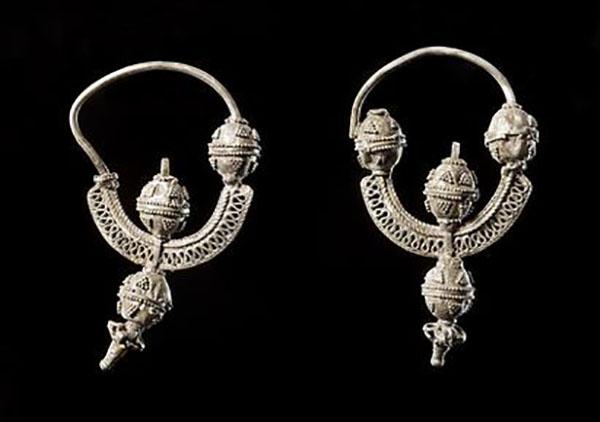🚚 Free shipping on orders over $60 + 10% off with code VIKING10
🚚 Free shipping on orders over $60 + 10% off with code VIKING10
Viking Earrings
Have a look at our inspired collection of Viking earrings!
Our selection of Viking earrings will allow you to shine among your loved ones. Representing the Nordic mythology, they will be a great way to pay tribute to them. Go for Thor and his hammer Mjolnir. Or bet on a model recalling the wolves Geri and Freki.
If you prefer jewelry reminiscent of Scandinavian earrings, our selection of products will satisfy everyone.
Made with quality materials, our craftsmen carefully apply themselves to offer high quality Viking jewelry, combining beauty, impeccable quality and impressive lightness.
Our collection includes small and large models, with spiral, hook and with or without clasp. Men and women, there is something for every style and taste!
The ancient origin of Earrings
Worn today as symbol, earrings have not always had this meaning throughout history.
Today, the earlobe is the oldest part of the human body to undergo transformations. The oldest earrings were discovered during an excavation in the city of Chifeng, Mongolia. Belonging to the Xinglongwa culture, they would have between 7500 and 8000 years and are made of jade stone. Only, at that time, no pierced earlobe, the earrings were only pinched.
Among the Mongolian people, several centuries ago, the earrings are so heavy that women see their earlobes distended or torn. They consider that it is worth it because in addition to the assets of seduction, the buckles made it possible to affirm the social status and the wealth.
In this part of the world, Buddhists have a similar meaning for ear jewelry. According to legend, Buddha was a prince of high rank. He flaunted his status through his jewelry, especially the large earrings. When he decided to give up this privileged life, he removed his jewelry but his lobes will forever recall this period. Moreover, the statues of Buddha have notably extended lobes.
Even more ancient traces of the presence of earrings in human culture are found in Exodus. In this biblical book, during the episode of the golden calf, it is said that, while Moses was at the top of Mount Sinai, the Israelites ask Aaron to make them a god. He then asked them to offer the jewelry of their wives and children, including earrings.
In Ancient Egypt also, these decorative objects are present. We know that the pharaohs and their people were very fond of jewelry. Necklaces, rings decorated in particular the pharaohs in their tombs. During this civilization, women wore gold earrings. The aesthetic aspect counted a lot.
In Rome, in a country which today has a certain place in fashion, earrings are part of the ornaments worn by women. Of simple manufacture, gold is very appreciated by the wealthy classes during the first centuries of the Republic. The Oppia law was even passed during the second Punic war to curb the enthusiasm of Roman women, who were wearing too much jewelry.
In the classical period, in the Italian capital, the Roman women wore earrings by two or three. They finally had a bell below the ears. Under the emperor Augustus, the popular classes sported models made of carnelian or fake precious stones. But the return of the general Pompey will create the fashion of the earrings in pearl, which cannot be imitated.
Norse Earrings among the Vikings
In the Nordic civilization, all forms of jewelry were important. The Vikings particularly appreciated necklaces, bracelets and rings. Earrings were also part of the jewelry worn. It is, as in other cultures, a way to embellish his dress, his outfit. But not only.
In the Viking culture, jewelry has several meanings. It is a mark that allows one to assert one's place in society. Although Viking men liked to wear jewelry, they did not wear earrings. This type of jewelry is therefore reserved for women.
Viking queens and other women with an important place in society wore earrings. With this jewelry, they could shine among their people and show that they were the most important women in their villages. However, earrings were rarer than necklaces, rings or other bracelets. This can be explained by the fact that this type of jewelry was worn by important women, who were then few in number.
Their mastery of the forge allowed the craftsmen to make beautiful pieces, with a good dose of small details. To create such jewelry, Viking makers used bronze and silver. But they could also opt for glass to create something unique. High quality pieces were made of gold. In northern Europe, Viking earrings from the 12th century were found, with a weight of 22 carats.

Among the Scandinavians, jewelry counts a lot. As in other civilizations of the world, Viking women put earrings on their daughters from childhood. For a child, this type of jewelry is made of gold, a rare material for this type of object. They keep them until adolescence, when the girls can then change their own jewelry.

To convince oneself of their importance, one must know that jewelry has a strong sentimental value. At weddings, for example, Vikings give each other jewelry, such as earrings from a mother to her daughter. Passed down from generation to generation, Viking ornaments are often linked to romantic memories. They are also real good luck charms that women did not part with.
Finally, like all other jewels, earrings could also be used as currency within the Scandinavian community. The barter system was very developed and the exchange containing amulets or bracelets was common. Buying a product on the market could be done with earrings.
This is why the Nordic people attached so much importance to the looting they did throughout Europe.
Styles for all tastes
The Nordic people appreciated earrings with a strong symbolism. It was therefore very common to find such jewelry reminding their gods.
But there are also different models of jewelry.
Historically, let's go back to the 10th century. At that time, the earring is in the form of a ring. On one end is a ball while there is a thin point on the other to facilitate the introduction in the lobe. The lower part of the ring is composed of a triangular part and a hollow part, giving an impression of relief.
Around the 11th and 12th centuries, earrings have animal shapes, engraved in gold. Bird shapes are popular because they are aesthetic. But it is also a symbol of the emperor.
A short trip back in history with a jump to Africa. Here too, the earring has an essential aesthetic role. But that's not all. Jewelry is also used to show wealth and status in society. The bigger they are, the richer you are.
Earrings, also visible as amulets, are present when women wear their traditional outfits. But they also have an unsuspected practical side. It is well known that African women carry on their heads all sorts of objects in balance, basins or containers. To avoid spilling everything on the ground, the earrings were used as a balance. They were a sign of a possible imbalance and of a coming fall.
In Africa, the jewels hung on the earlobes are sometimes particular. Today, there are several types of earrings according to their style and method of hanging:
- Fleas: they seem to float on the earlobe. The attachment is not visible but it exists, it is a rod that crosses the ear. Made of gold or silver, they are rather discreet and are similar to pins today.
- The rings: they can be circular or semi-circular. If they are circular, they are hollow and a thin attachment passes through the ear. A pivot at the front and folded back also works. If they are semi-circular, they are held in place by a metal stroller.
- The hooks: they are made of a curved metal rod to facilitate the attachment to the lobe.
- Sleepers: Similar to hooks, sleepers have an additional attachment at the back. This one is not dissociable from the rest of the clip and can be rotated. They are often the support of long earrings.
Viking women used rings and chips a lot, because they were easy to make and easy to hang. By the way, did you know how to put on your earrings correctly?
How to put on mens viking earrings?
Putting on mens viking earrings necessarily requires having the earlobes pierced. Today, ear piercing guns exist, but the Vikings and ancient cultures used another technique.
They used a sewing needle to pierce and then placed a soft object behind the ear to stop it. To make the healing better, an earring was placed directly into the hole.
Before putting the earrings on the lobes, it is necessary to prepare them well. For this, nothing better than cleaning them. Take a cotton soaked in alcohol and then slide the earrings inside. This step will remove any bacteria that may be on the curls. So take the time to do this every time you put the earrings on.
To place your earrings, start by putting them in the hole in your lobe. Slide the end in by twisting the jewelry slightly on itself. Push the earring in until the front of the earring is positioned the way you want it.
If the jewel has trouble positioning itself, don't hesitate to lubricate it. Smearing Vaseline on the spike can make it easier to put on. Another tip is to pull on the earlobe to facilitate the insertion of the earring. By doing this, the hole will temporarily widen and it will be easier to put the jewel in. The more you wear earrings, the easier and faster it will be to put them in.
The last step depends on the type of jewelry you are hanging on your ear. In general, you have to put the clasp in place. To do this, simply bring the back of the clasp to the center of the metal spike and slide it on. If the earring is simply mounted on a hook, make sure it is well closed. If it's a Creole earring, slide the ring into your ear until you feel a smooth part touching your lobe. Simply close the jewelry and turn it to position the clasp behind your ear. Use a mirror if you are not sure of its placement.
Finally, don't forget to store your earrings in a safe place. They are such small items that it is easy to lose them. And with the happiness they bring, it would be unfortunate to lose your Viking earrings.























































































































